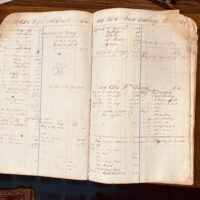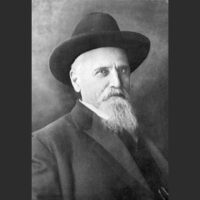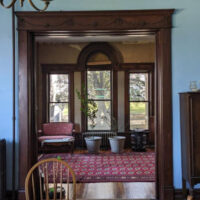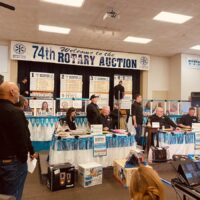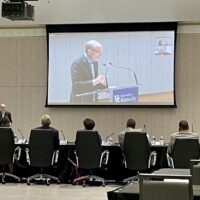Made of a deep red satin, this jacket features 15 snap buttons and is trimmed on its collar, cuffs and pockets with a cream satin. Belt loops around the waist hold a cream satin belt. Accompanying the jacket is a red satin cap with a cream satin band and a large bow.
When I had the idea to write about specific artifacts in the museum’s collection, I knew that I had to write about this one. It is simply stunning. The colors are rich, and the fabric is luxurious — so much so that it was stored with women’s blouses. But it is not a woman’s blouse. This vibrant satin jacket, belt and hat were worn by a skilled driver and well known horseman in local harness races.
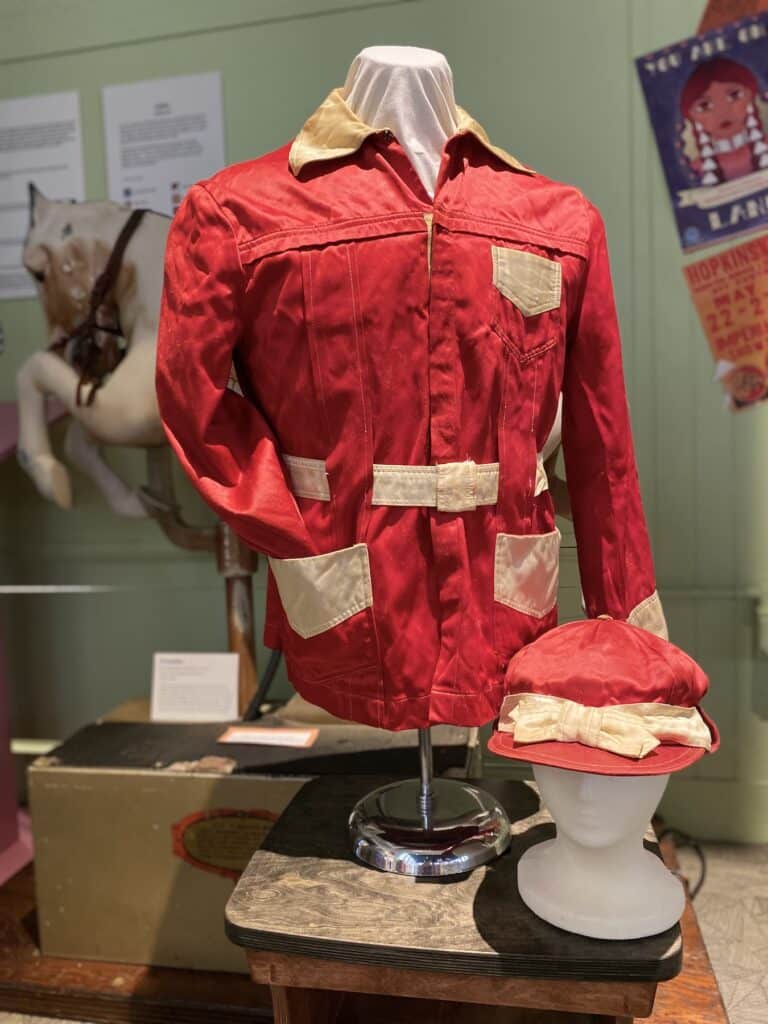
The deed of gift for this item turned out to be a gem in itself. Signed by one woman, it listed her name and those of her four sisters. She supplied a handwritten history of the artifacts — information that would have been difficult to piece together on our own. That’s the beauty (and sometimes the curse) of our vast collection. Each item has the potential to tell a fascinating account of a time, a place or a person, but only if we are able to capture those stories.
So, what makes this satin jacket so interesting to us? It tells the story of harness racing, of that sport’s popularity, and of how it was a huge draw for the Hopkinsville fair each summer.
The jacket and matching hat belonged to Henry G. Adcock, local breeder and trainer of standardbred horses. Adcock was a founding member of the board of the Pennyroyal Fair in 1951, and it was through his leadership that the race track was constructed at the fairgrounds. He even served as the Superintendent of Speed for the fair for a number of years. (Note: I am dying to know the responsibilities one carries as the Superintendent of Speed!) Drivers of his horses wore this crimson and cream silk — registered by Adcock with the U.S. Trotting Association just like owners register silks with the Jockey Club for thoroughbred races — in the 1950s and ’60s.
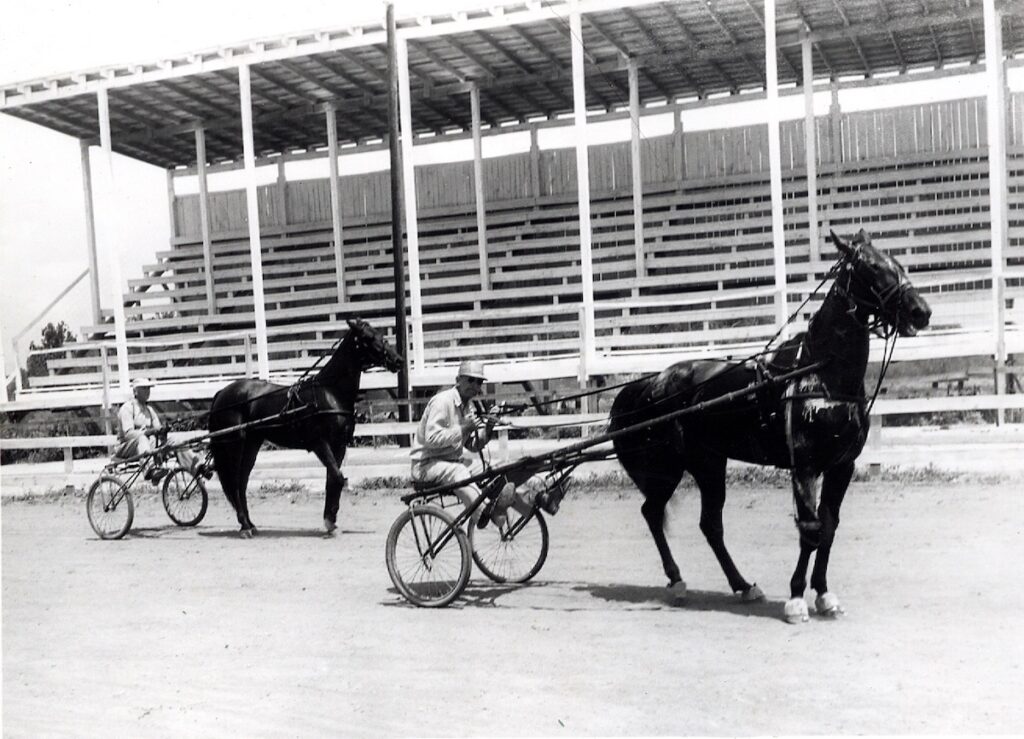
Born in Hopkinsville in 1896, Adcock served in World War I and farmed for the majority of his life. Based on the report of his daughters, the donors of the racing silk, and his obituary in 1992, horses were his thing. As a breeder, trainer and driver, he became widely known in racing circles throughout the eastern United States and Canada.
The history of horse breeding and racing dates back to the late 19th century in Christian County. Charles Meacham’s “History of Christian County: From Oxcart to Aeroplane,” published in 1930, dedicates an entire chapter to our county’s race horse industry. His recounting of local breeders and of prize-winning horses illustrates how lucrative the business was for this community. In 1923, one of these horses was sold for $21,000 at the thoroughbred yearling auction in Saratoga, New York. That Christian County horse — Flying Ebony — went on to win the 1925 Kentucky Derby.
Harness racing had been a regular feature at earlier fairs in Christian County. Also known as “sulky racing,” this sport features standardbred horses who race at a specific gait — either a trot or a pace — while pulling a small, two-wheeled cart with a skilled driver. The lightweight cart is known as a sulky or spider. The term “sulky” is said to have originated because the cart is so small that it can only hold one person — or someone who sulks and prefers to be alone.
Races are divided into trot and pace heats. Trotters move their legs forward in diagonal pairs with the right front and left hind legs striking the ground simultaneously followed by the left front and right hind legs. Pacers move their legs laterally with the two right legs moving together before the two left legs. Pacing is a faster gait than trotting. Breaking the specified gait could lead to a disqualification in a race. (I had to watch a YouTube video to understand this … even a little bit.)
The new Pennyroyal Fair, established in 1951, did not have the capacity to host harness races in its first few years. But that didn’t last long thanks to H.G. Adcock. In 1954, the fair board raised the funds to purchase the beginnings of the fairgrounds we still use today. According to a history of the Pennyroyal Fair printed in the 1958 Premium List and Program Schedule, a one-half acre race track and grandstand were constructed in 1954. In 1956, two stables totaling 74 stalls were added to the fairgrounds to accommodate both harness and show horses. H.G. Adcock served as the Superintendent of Harness Racing during this massive development phase.

Harness racing dominated the fair calendar with races on three to four days and nights. The purses paid out to the winners amounted to the biggest expense of the fair. Harness racing was big time and pretty big money. A 1958 booklet lists purses ranging from $200 to $400 per race.
Back to Adcock. He wasn’t just a fair board member and superintendent. He was also actively involved in harness racing and drove his own horses in races near and far. On Aug. 5, 1958, Adcock’s horse Lady Goose, a 4-year old pacer, set the track record at the Pennyroyal Fair beating the previous record by 2 seconds. The Kentucky New Era noted that this was Lady Goose’s ninth win of the year. Adcock’s picture with his prized pacer ran in the newspaper. The black and white photograph is dark, but Adcock is most definitely wearing this same red satin jacket that is now in the museum’s collection and currently on display.
Track record holder Lady Goose made a name for herself locally, but Adcock also once owned another horse who made it to the big screen. Visalia Abbe, a dark bay, starred in the 1949 film “The Great Dan Patch” as noted American Standardbred pacer Dan Patch. A record breaker and a movie star — looks like we have a couple of equine Local Notables to add to the exhibit at the Pennyroyal Area Museum!
